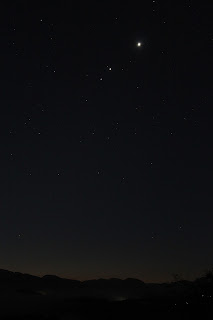Last week I stumbled across an ad of an amateur astronomer who wanted to sell his 127/635 achromatic refractor – it was a real bargain. Even though I was not particularly searching for such an instrument, I could not resist. I already own a refractor telescope with a focal length of 1000mm – the moon or the sun fill up the entire image. While this is nice for detailed images, I miss the possibility to get some more background in the pictures. This would be nice for images of setting or rising moon and sun, respectively. Also, close conjunctions of planets can be documented more easily (only two days ago it was hard work to get Venus and Jupiter in one picture with 1000mm focal length).
From what I
can say so far, the telescope performs as expected. Sure enough, we are
overcast now (there seems to be a law which says thou shalt not observe on the
day you obtain a telescope) – but a tiny hole in the clouds allowed me to take
some snapshots of the moon.
- - - - - -
- - - - - - - - - - - - - - - - - - - - - - - -
Letzte Woche stolperte ich über eine Anzeige eines
Amateurastronomen, der seinen 127/635 Achromaten verkaufen wollte – es war ein
echtes Schnäppchen. Auch wenn ich nicht wirklich nach einem solchen Instrument
Ausschau hielt, konnte ich nicht widerstehen. Ich besitze schon einen Refraktor
mit einer Brennweite von 1000mm – Mond und Sonne füllen das ganze Bild aus.
Während das für detaillierte Aufnahmen ganz nett ist, so vermisse ich doch die
Möglichkeit, etwas mehr Hintergrund ins Bild zu bekommen. Das wäre nett für
Bilder des auf- oder untergehenden Mondes oder der Sonne. Auch enge Begegnungen
von Planeten können so einfacher dokumentiert werden (vor gerade einmal zwei
Tagen war es recht schwer, Venus und Jupiter in ein Bild mit 1000mm Brennweite
zu bekommen.
Bisher kann ich sagen, dass das Teleskop wie erwartet
funktioniert. Natürlich ist es jetzt bei uns bedeckt (es scheint ein Gesetz zu
geben dass besagt: Du sollst nicht beobachten an dem Tage, an welchem du ein
Teleskop erhältst) – aber eine winzige Wolkenlücke hat es mir doch gestattet,
ein paar Schnappschüsse des Mondes aufzunehmen.
- - - - - -
- - - - - - - - - - - - - - - - - - - - - - - -
- - - - - -
- - - - - - - - - - - - - - - - - - - - - - - -
Pictures
from top to bottom:
(1) My new preowned 127/635 refractor telescope Messier from Bresser
(2) First picture of the moon through this telescope
- - - - - - - - - - - - - - - - - - - - - - - - - - - - - -
Bilder von oben nach unten:
(1) Mein neuer gebrauchter 127/635 Refraktor Messier von Bresser
(2) Erstes Bild des Mondes durch dieses Teleskop






















